Can aftermarket cat converters run cleaner than the stock one?
#1
My RX-7 is mostly stock, and has been running around on the stock cat converter for about 98,000 miles now. The last time I had my car smog tested, the tech informed me that the cat converter will probably need to be replaced soon. It has been a while since the car was bone stock with low miles, and the exhaust smell does seem worse especially when the engine is cold.
Searching suggests that OEM Mazda catalytic converters are no longer available new, and some of the aftermarket cats either wear out quickly or do a poor job of cleaning up the exhaust when new. Given that there have been two decades of improved emissions technology and ever-tightening emissions laws, it seems to me that we should be able to find cat converters that outperform the stock one in both flow and emissions scrubbing. The aftermarket has progressed the the point that we can replace the original turbochargers, injectors, and ECU with new ones that will make more power without sacrificing good driving manners. I'm hoping that someone out there might know if it's possible to do something similar by ditching the 20-year-old cat converter design.
My specific goals with regard to the cat converter are as follows:
1. Stock emissions or better, specifically the ability to pass a California 15 & 30mph dyno smog test without using tricks like denatured alcohol. Personally I'd like the exhaust to smell less toxic than it currently does, but that's difficult to quantify.
2. Similar or decreased restriction compared to the stock cat converter. I might be willing to tolerate a minor drop in power assuming it could be regained by swapping to an aftermarket muffler without making the car much louder... the car currently has stock sequential twins, an aftermarket downpipe and stock muffler. Future plans may include an EFR7670 with the goal of quicker spool and ~300whp, but probably not this year.
It seems aftermarket cats are pretty cheap compared to the prices I saw quoted when the OEM Mazda ones were available, so I don't mind the idea of running two aftermarket high-flow cat converters in a row if it will meet my goals. I think I'm less likely to kill an aftermarket cat than people were 10 years ago, with the aftermarket ECU and injectors the engine idles happily at about 14:1 AFR when cold and 15:1 AFR when warm. It was running richer than that on the stock ECU and injectors.
Assuming that the aftermarket cats aren't much good, I'm also OK with the idea of a cat converter that was designed for another car. Newer Mustangs and Camaros are making over 400hp and adhering to much more stringent emission standards, and I suspect people who modify those cars might be willing to part with their OEM cat converters for pretty cheap.
I realize it's less sexy to make 300hp and burn clean than to make 500hp with a car that smells bad, but I doubt I'm a fast enough driver to handle 350hp in this chassis anyways. There are plenty of smart people on here so I'm hoping someone might happen to be familiar with this sort of thing and willing to offer some advice. Thanks in advance.
Searching suggests that OEM Mazda catalytic converters are no longer available new, and some of the aftermarket cats either wear out quickly or do a poor job of cleaning up the exhaust when new. Given that there have been two decades of improved emissions technology and ever-tightening emissions laws, it seems to me that we should be able to find cat converters that outperform the stock one in both flow and emissions scrubbing. The aftermarket has progressed the the point that we can replace the original turbochargers, injectors, and ECU with new ones that will make more power without sacrificing good driving manners. I'm hoping that someone out there might know if it's possible to do something similar by ditching the 20-year-old cat converter design.
My specific goals with regard to the cat converter are as follows:
1. Stock emissions or better, specifically the ability to pass a California 15 & 30mph dyno smog test without using tricks like denatured alcohol. Personally I'd like the exhaust to smell less toxic than it currently does, but that's difficult to quantify.
2. Similar or decreased restriction compared to the stock cat converter. I might be willing to tolerate a minor drop in power assuming it could be regained by swapping to an aftermarket muffler without making the car much louder... the car currently has stock sequential twins, an aftermarket downpipe and stock muffler. Future plans may include an EFR7670 with the goal of quicker spool and ~300whp, but probably not this year.
It seems aftermarket cats are pretty cheap compared to the prices I saw quoted when the OEM Mazda ones were available, so I don't mind the idea of running two aftermarket high-flow cat converters in a row if it will meet my goals. I think I'm less likely to kill an aftermarket cat than people were 10 years ago, with the aftermarket ECU and injectors the engine idles happily at about 14:1 AFR when cold and 15:1 AFR when warm. It was running richer than that on the stock ECU and injectors.
Assuming that the aftermarket cats aren't much good, I'm also OK with the idea of a cat converter that was designed for another car. Newer Mustangs and Camaros are making over 400hp and adhering to much more stringent emission standards, and I suspect people who modify those cars might be willing to part with their OEM cat converters for pretty cheap.
I realize it's less sexy to make 300hp and burn clean than to make 500hp with a car that smells bad, but I doubt I'm a fast enough driver to handle 350hp in this chassis anyways. There are plenty of smart people on here so I'm hoping someone might happen to be familiar with this sort of thing and willing to offer some advice. Thanks in advance.
Last edited by scotty305; 03-09-16 at 02:24 AM.
#2
From what I understand, the stock catalytic converter is a ceramic unit with 600-800 CPSI and quite a large honeycomb (actually I think there are two with the air pump injecting oxygen in the middle. The flow of the stock unit is actually very good with it's main downfall being that the 2.5" diameter piping is shrunk down to 2.25" (or maybe slightly less) at the joining ends of each pipe that connect to the downpipe and cat-back exhaust.
When replacing the cat, most people opt for a high flow 3" unit which is metallit and 200 CPSI or less. Naturally, the less CPSI the less efficient the cat will be because it lets more gases pass through than the stock unit. The other issue with several high flow units is that the catalytic converter itself has a significantly smaller total surface area than the stock unit despite being 3" in diamter, i.e. the flow is better but the actual honeycomb is a lot smaller in general regardless of the CPSI.
In January, I replaced my downpipe and ended up having to replace my stock catalytic converter because the honeycomb was cracked. I found a used 3" RE-Amemiya converter for sale which is 150 CPSI and welded a pipe just ahead of the converter to attach the air pump.
Now, in the UK RX-7s older than 1995 don't need a cat and the majority of the ones newer than 1995 are Japanese imports which for one reason or another struggle to pass the stringent emissions tests legally if at all modified. Therefore, most people with RX-7s simply run a straight through mid pipe and pay the smog tester a bit extra to "pass" their car.
My car passed legally with the stock cat and I have a guy that can pass the car for me otherwise but I went with the high flow cat in the hopes of being able to pass legally, but more importantly I didn't want my car to smell like a fuel refinery as my previous RX-8 was decatted and the smell was a nightmare.
Long story short, the RE-Amemiya cat on my car is not efficient enough to pass emissions even by leaning out the car for the specific idle and 30 mph 2,500 RPM test with the Power FC (car didn't like running that lean). My results are below and I would say based on the results a 400 CPSI converter or thereabouts should be able to pass and in my opinion, you aren't giving up that much power running a converter anyway so I wouldn't worry about it, despite what most people on the internet will say. I am confident you could probably make 500 bhp on the stock converter if you wanted to but then heat might become a problem for a circuit car.
Therefore, in your case try to find a 400 CPSI or higher converter. Maybe buy a used RX-8 converter, cut out the cat and have an exhaust shop weld new pipe work to connect to your downpipe and cat-back.
Stock Cat on My Car
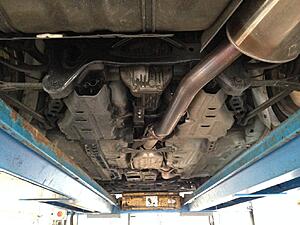
Stock Cat Honeycomb Density and Cracked
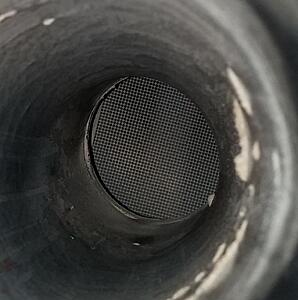
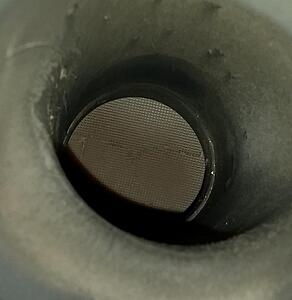
3" RE-Amemiya 150 CPSI Honeycomb Density Comparison
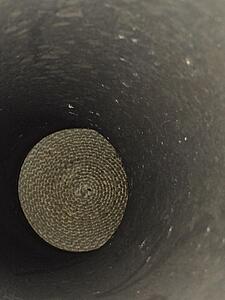
RE-Amemiya Cat Installed with Air Pump
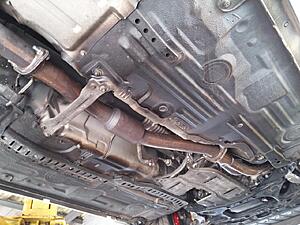
Emissions Results with RE-Amemiya Cat and lean emissions tune
Normal Idle
Carbon Monoxide ("CO") - 0.5% (UK RX-7 limit - 0.5%)
Hydrocarbon ("HC") - No requirement (UK RX-7 limit - No requirement)
Raised Engine Speed (c.2,500 RPM)
CO - 0.3% (UK RX-7 limit - 0.3%)
HC - 0.02% or 200ppm (UK RX-7 limit - 0.02% or 200ppm)
Lambda - 1 +/- 0.03 (UK RX-7 limit - 0.97 to 1.6)
Idle
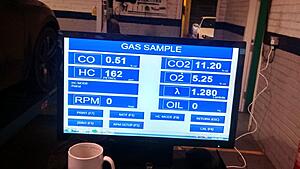
c.2,500 RPM
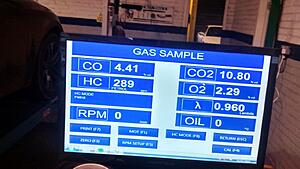
When replacing the cat, most people opt for a high flow 3" unit which is metallit and 200 CPSI or less. Naturally, the less CPSI the less efficient the cat will be because it lets more gases pass through than the stock unit. The other issue with several high flow units is that the catalytic converter itself has a significantly smaller total surface area than the stock unit despite being 3" in diamter, i.e. the flow is better but the actual honeycomb is a lot smaller in general regardless of the CPSI.
In January, I replaced my downpipe and ended up having to replace my stock catalytic converter because the honeycomb was cracked. I found a used 3" RE-Amemiya converter for sale which is 150 CPSI and welded a pipe just ahead of the converter to attach the air pump.
Now, in the UK RX-7s older than 1995 don't need a cat and the majority of the ones newer than 1995 are Japanese imports which for one reason or another struggle to pass the stringent emissions tests legally if at all modified. Therefore, most people with RX-7s simply run a straight through mid pipe and pay the smog tester a bit extra to "pass" their car.
My car passed legally with the stock cat and I have a guy that can pass the car for me otherwise but I went with the high flow cat in the hopes of being able to pass legally, but more importantly I didn't want my car to smell like a fuel refinery as my previous RX-8 was decatted and the smell was a nightmare.
Long story short, the RE-Amemiya cat on my car is not efficient enough to pass emissions even by leaning out the car for the specific idle and 30 mph 2,500 RPM test with the Power FC (car didn't like running that lean). My results are below and I would say based on the results a 400 CPSI converter or thereabouts should be able to pass and in my opinion, you aren't giving up that much power running a converter anyway so I wouldn't worry about it, despite what most people on the internet will say. I am confident you could probably make 500 bhp on the stock converter if you wanted to but then heat might become a problem for a circuit car.
Therefore, in your case try to find a 400 CPSI or higher converter. Maybe buy a used RX-8 converter, cut out the cat and have an exhaust shop weld new pipe work to connect to your downpipe and cat-back.
Stock Cat on My Car

Stock Cat Honeycomb Density and Cracked


3" RE-Amemiya 150 CPSI Honeycomb Density Comparison

RE-Amemiya Cat Installed with Air Pump

Emissions Results with RE-Amemiya Cat and lean emissions tune
Normal Idle
Carbon Monoxide ("CO") - 0.5% (UK RX-7 limit - 0.5%)
Hydrocarbon ("HC") - No requirement (UK RX-7 limit - No requirement)
Raised Engine Speed (c.2,500 RPM)
CO - 0.3% (UK RX-7 limit - 0.3%)
HC - 0.02% or 200ppm (UK RX-7 limit - 0.02% or 200ppm)
Lambda - 1 +/- 0.03 (UK RX-7 limit - 0.97 to 1.6)
Idle

c.2,500 RPM

Last edited by cib24; 03-09-16 at 10:45 AM.
The following users liked this post:
adey (03-20-19)
#3
As your oem cat ages, some of the "honeycomb" breaks down, and gets filled with particles. This acts to restrict flow and the ability to burn as cleanly as it should. You may be able to do something about it, at no cost:
I removed my oem cat several years ago, and simply shook it out. I was able to get a lot of particulate matter out of both ends. Take your time when doing this. The result should be a better flowing, cleaner burning cat.
While you have it out, you may want to consider welding the flanges on the outside, and grinding off the welds on the inside of the flanges. This will essentially increase your exhaust diameter from 2 1/8" to a full 2 1/2". A huge difference in flow!!!
Hope this works as well for you as it did for me.
I removed my oem cat several years ago, and simply shook it out. I was able to get a lot of particulate matter out of both ends. Take your time when doing this. The result should be a better flowing, cleaner burning cat.
While you have it out, you may want to consider welding the flanges on the outside, and grinding off the welds on the inside of the flanges. This will essentially increase your exhaust diameter from 2 1/8" to a full 2 1/2". A huge difference in flow!!!
Hope this works as well for you as it did for me.
#4
From what I understand, the stock catalytic converter is a ceramic unit with 600-800 CPSI and quite a large honeycomb (actually I think there are two with the air pump injecting oxygen in the middle. The flow of the stock unit is actually very good with it's main downfall being that the 2.5" diameter piping is shrunk down to 2.25" (or maybe slightly less) at the joining ends of each pipe that connect to the downpipe and cat-back exhaust.
I seem to remember reading in the Yamaguchi book the US spec FD stock main cat is actually a metal substrate cat.
Here in the US emissions parts have to have a manufacturer warranty period of 10 years.
We also have a pre-cat in the downpipe on the FD here that is not on the JDM models.
I bet a stock cat from a new car would be the best for smog, but may not last as long as the original if it isn't a metal cat.
The RX-8 main cat would be the logical go-to cat to take the rotary abuse, except it looks tiny with small piping as well.
I seem to remember reading in the Yamaguchi book the US spec FD stock main cat is actually a metal substrate cat.
Here in the US emissions parts have to have a manufacturer warranty period of 10 years.
We also have a pre-cat in the downpipe on the FD here that is not on the JDM models.
I bet a stock cat from a new car would be the best for smog, but may not last as long as the original if it isn't a metal cat.
The RX-8 main cat would be the logical go-to cat to take the rotary abuse, except it looks tiny with small piping as well.
#6
j9fd3s and his encyclopedic knowledge referenced a catalytic converter originally manufactured for a '90s era Ford truck that was about the same size (read big) as the main cat on the RX-7. It's not new tech and you'd have to check piping diameter, but it may still be available. Hopefully, he'll chime in.
#7
cib24
I thought the entire RX-8 exhaust system was 2.5" in diameter and very good flowing which is why aftermarket exhaust products on that car don't usually result in an increase in bhp beyond about 5.
On an NA car any increase in pipe diameter and subsequent decrease in exhaust velocity decreases the affects of scavenging and increases pumping losses.
OP is looking for a cat that will be more efficient than his old stock cat and flow more than stock FD cat.
Stock FD cat is a huge restriction to the FD on its own. Take it out or put a high flow cat in and you get huge boost creep.
Trending Topics
#8
Thanks for all the info everyone. I have easy (cheap) access to a couple of Magnaflow cat converters that were left over from a friend's hot rod project. I need to dig and find actual part numbers but they are probably 3 inch diameter, 400CPI. I may roll the dice and ask a fabricator to build a pipe that uses two 3" Magnaflow cats to replace the stock converter, and see how that works. Unfortunately I no longer have access to a flow bench to compare flow restriction, but luckily I do have access to a chassis dyno to test if the new setup gains or loses power.
#9
There are a few things to keep in mind.
A completely stock series 6 FD in US spec had to meet US cold start emissions standards for certification. That's what the precat is for, and the accelerated warmup system. Most tailpipe emissions are generated on a cold start, when the mixture needs to be richer and the cat hasn't warmed up yet.
These smog station tests, at least in California, are hot tests. The engine is already warmed up, and it's run in a steady state. Tailpipe emissions should be basically 0 under those conditions, as long as the other emission devices are working right (o2 sensor, ECU programming, secondary air injection system). They are very easy tests to pass, relatively speaking, compared to a certification test on a new vehicle.
Aftermarket cats have way less precious metal loading than OEM cats. That's ones of the reasons why they're cheaper. You can get away with that when you are only doing hot tests (no cold start portion). I find it unlikely that any aftermarket cat is going to have comparable emission performance to an OEM one. Part of it is that OEM cats are restrictive in an intentional way, to direct exhaust gases inside for best emissions. That being said, an old OEM cat is probably long dead, and in that case an aftermarket one will get the job done for steady state hot testing.
You can tell if the cat is doing its job based on an emission analyzer calculating cat efficiency by sampling emissions before and after the cat. That kind of equipment is only available in an R&D lab.
Cats degrade based on heat load. If you've modded your car at all, there's a good chance it's experiencing accelerated degradation compared to stock. The only way to know is to put an EGT probe physically inside the catalyst brick. You have to have a spec on it, but usually over 850-950C and you're cooking the thing. There are special drive cycles for cat overtemp/durability check, such as the standard road cycle https://www.dieselnet.com/standards/cycles/src.php.
A completely stock series 6 FD in US spec had to meet US cold start emissions standards for certification. That's what the precat is for, and the accelerated warmup system. Most tailpipe emissions are generated on a cold start, when the mixture needs to be richer and the cat hasn't warmed up yet.
These smog station tests, at least in California, are hot tests. The engine is already warmed up, and it's run in a steady state. Tailpipe emissions should be basically 0 under those conditions, as long as the other emission devices are working right (o2 sensor, ECU programming, secondary air injection system). They are very easy tests to pass, relatively speaking, compared to a certification test on a new vehicle.
Aftermarket cats have way less precious metal loading than OEM cats. That's ones of the reasons why they're cheaper. You can get away with that when you are only doing hot tests (no cold start portion). I find it unlikely that any aftermarket cat is going to have comparable emission performance to an OEM one. Part of it is that OEM cats are restrictive in an intentional way, to direct exhaust gases inside for best emissions. That being said, an old OEM cat is probably long dead, and in that case an aftermarket one will get the job done for steady state hot testing.
You can tell if the cat is doing its job based on an emission analyzer calculating cat efficiency by sampling emissions before and after the cat. That kind of equipment is only available in an R&D lab.
Cats degrade based on heat load. If you've modded your car at all, there's a good chance it's experiencing accelerated degradation compared to stock. The only way to know is to put an EGT probe physically inside the catalyst brick. You have to have a spec on it, but usually over 850-950C and you're cooking the thing. There are special drive cycles for cat overtemp/durability check, such as the standard road cycle https://www.dieselnet.com/standards/cycles/src.php.
#10
Moderator
iTrader: (3)
Joined: Mar 2001
Posts: 31,203
Likes: 2,826
From: https://www2.mazda.com/en/100th/
j9fd3s and his encyclopedic knowledge referenced a catalytic converter originally manufactured for a '90s era Ford truck that was about the same size (read big) as the main cat on the RX-7. It's not new tech and you'd have to check piping diameter, but it may still be available. Hopefully, he'll chime in.
sadly we can't use it in CA anymore, because they have a new certification program, and the cat either needs to be the OEM one (which i think you can still get), or a CARB certified one.
There are a few things to keep in mind.
These smog station tests, at least in California, are hot tests. The engine is already warmed up, and it's run in a steady state. Tailpipe emissions should be basically 0 under those conditions, as long as the other emission devices are working right (o2 sensor, ECU programming, secondary air injection system). They are very easy tests to pass, relatively speaking, compared to a certification test on a new vehicle.
Aftermarket cats have way less precious metal loading than OEM cats. That's ones of the reasons why they're cheaper. You can get away with that when you are only doing hot tests (no cold start portion). I find it unlikely that any aftermarket cat is going to have comparable emission performance to an OEM one. Part of it is that OEM cats are restrictive in an intentional way, to direct exhaust gases inside for best emissions. That being said, an old OEM cat is probably long dead, and in that case an aftermarket one will get the job done for steady state hot testing.
These smog station tests, at least in California, are hot tests. The engine is already warmed up, and it's run in a steady state. Tailpipe emissions should be basically 0 under those conditions, as long as the other emission devices are working right (o2 sensor, ECU programming, secondary air injection system). They are very easy tests to pass, relatively speaking, compared to a certification test on a new vehicle.
Aftermarket cats have way less precious metal loading than OEM cats. That's ones of the reasons why they're cheaper. You can get away with that when you are only doing hot tests (no cold start portion). I find it unlikely that any aftermarket cat is going to have comparable emission performance to an OEM one. Part of it is that OEM cats are restrictive in an intentional way, to direct exhaust gases inside for best emissions. That being said, an old OEM cat is probably long dead, and in that case an aftermarket one will get the job done for steady state hot testing.
and more weirdly the only piston car i've ever smogged that was anywhere near this was a 1980 MGB running a bit lean. not much combustion happening in that engine...
its been my experience that the FD cat is basically bomb proof, if it doesn't pass smog its always something else. the 02 sensors tend to be bad, and it could be something with the air injection too
#11
"The main portion of the 2-stage, 5-bed oxidizing, 3-way catalyst system is a monolith metal-carrier type, possessing extremely low flow resistance." Pg 84 Yamaguchi, RX-7
That "metal-carrier type" is what made me think he was saying the main cat was metal core.
Now in 2016 with the availability of aftermarket cats we can argue that last portion of the quote "possessing extremly low flow resistance."
That "metal-carrier type" is what made me think he was saying the main cat was metal core.
Now in 2016 with the availability of aftermarket cats we can argue that last portion of the quote "possessing extremly low flow resistance."
#14
Great thread, guys. Am learning loads.
How would one counter the boost creep on stock turbos? Is this because the stock wastegate(s) don't flow enough for the increased boost?
How would one counter the boost creep on stock turbos? Is this because the stock wastegate(s) don't flow enough for the increased boost?
#17
#19
Stocks cats are known to break down and the honeycomb slowly gets fired out the exhaust. I scrapped one off my '92 car the other day, only about a quarter of the honeycomb was left in the cat. The oem cat is still available new, but it's crazy expensive, there are plenty of good aftermarket options out there.
#20
Had a buddy who got a cheap weld-in high flow cat on his FD. Was very entertaining following his car when it ejected the packing of the high flow cat under boost  .
.
Rotaries are REALLY hard on cats, going with a cheap route most likely won't cut it. An evergreen option is the Bonez high-flow, it's been around for ages and works great.
Dale
 .
.Rotaries are REALLY hard on cats, going with a cheap route most likely won't cut it. An evergreen option is the Bonez high-flow, it's been around for ages and works great.
Dale
#21
Causes the car to run lean? (Why?)
Thanks!
#22
Replacing the main cat converter with a catless midpipe is known to decrease exhaust restriction so much that the stock ECU will run lean and/or overboost. The stock system has a MAP sensor, so it's estimating the actual airflow based on manifold pressure. Newer designs often include a MAF sensor to measure airflow more accurately, which has its own set of disadvantages but might handle major flow modifications better.
#23
The exhaust system generally referenced in this order: Downpipe ---> mid-pipe or catalytic converter ----> cat-back.
Installing a cat-less mid-pipe leaves insufficient back-pressure in the exhaust system. That leads to the small internal wastegate of the stock twin turbos to be overwhelmed. That leads to exhaust pressure being unable to bypass the turbine, which causes an over-boost situation. The additional boost isn't anticipated and at some point. not enough fuel is delivered (MAP or MAF) by the ECU as scotty305 described. The engine runs lean and is damaged from pre-ignition. The only way to avoid boost creep is to leave enough back pressure in the system, or remove the turbos and port (enlarge) the wastegate. And because the question comes up often, a boost controller will NOT control boost creep.
Installing a cat-less mid-pipe leaves insufficient back-pressure in the exhaust system. That leads to the small internal wastegate of the stock twin turbos to be overwhelmed. That leads to exhaust pressure being unable to bypass the turbine, which causes an over-boost situation. The additional boost isn't anticipated and at some point. not enough fuel is delivered (MAP or MAF) by the ECU as scotty305 described. The engine runs lean and is damaged from pre-ignition. The only way to avoid boost creep is to leave enough back pressure in the system, or remove the turbos and port (enlarge) the wastegate. And because the question comes up often, a boost controller will NOT control boost creep.
Last edited by Sgtblue; 03-23-19 at 03:50 PM.
#24
The exhaust system generally referenced in this order: Downpipe ---> mid-pipe or catalytic converter ----> cat-back.
Installing a cat-less mid-pipe leaves insufficient back-pressure in the exhaust system. That leads to the small internal wastegate of the stock twin turbos to be overwhelmed. That leads to exhaust pressure being unable to bypass the turbine, which causes an over-boost situation. The additional boost isn't anticipated and at some point. not enough fuel is delivered (MAP or MAF) by the ECU as scotty305 described. The engine runs lean and is damaged from pre-ignition. The only way to avoid boost creep is to leave enough back pressure in the system, or remove the turbos and port (enlarge) the wastegate. And because the question comes up often, a boost controller will NOT control boost creep.
Installing a cat-less mid-pipe leaves insufficient back-pressure in the exhaust system. That leads to the small internal wastegate of the stock twin turbos to be overwhelmed. That leads to exhaust pressure being unable to bypass the turbine, which causes an over-boost situation. The additional boost isn't anticipated and at some point. not enough fuel is delivered (MAP or MAF) by the ECU as scotty305 described. The engine runs lean and is damaged from pre-ignition. The only way to avoid boost creep is to leave enough back pressure in the system, or remove the turbos and port (enlarge) the wastegate. And because the question comes up often, a boost controller will NOT control boost creep.
Can it be solved with a Power-FC? (I guess just tune to add more fuel over a certain boost level?)
Any idea if this also happens on 1996+ (JDM) cars? I assume the turbos were at least somewhat changed between series 2 (USDM 1994-1995) and my '99 (series 5)?
(Just as a fun fact, porting the wg outlet is also something a few Nissan S-chassis guys have done on the stock SR20 T28 turbos!)
Thanks!!
#25
I'm not a tuner, but at some point even with a programable ECU, the fuel system (pump or injector duty) will hit it's limit. So no, a PFC isn't potection against creep. It might give you a little more head-room, but no guarantee.
And AFAIK, the wastegate wasn't enlarged in the later designs, so yes, it's still possible to have boost creep on 96 and later models.
And AFAIK, the wastegate wasn't enlarged in the later designs, so yes, it's still possible to have boost creep on 96 and later models.


